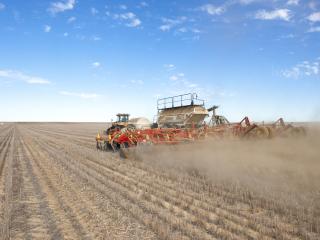The 2021 Western Australian Crop Sowing Guide [1] is now available to assist grain growers to plan next season’s seeding program, with a wealth of credible, independent material to optimise crop productivity and profitability.
The online and hard copy publication provides a one-stop-shop for crop variety and agronomic information so growers and consultants can evaluate and compare options to best suit their operations.
The annual publication was produced by the Department of Primary Industries and Regional Development and includes data from the Grains Research and Development Corporation’s National Variety Trials (NVT).
The essential compilation provides detailed variety guides for wheat, barley, oats, canola and pulses, including lupins, lentils, field pea, chickpea, faba beans and vetch.
Department crop science and grain production manager Bob French said the 2021 Guide had been updated with the latest industry developments.
“This valuable reference document will assist growers to make informed decisions about crop and variety selection, backed by NVT data, disease resistance ratings and agronomic advice,” Dr French said.
“It is particularly useful for growers considering a new crop variety, who can compare yields, quality and disease traits, while taking into account farm diversity, risk mitigation and current market requirements.”
The wheat section profiles three new offerings, the Australian Premium White variety Denison and the Australian Hard varieties Hammer CL Plus and Sting.
Dr French said the Guide also referenced the varieties that are to be removed from Wheat Quality Australia’s Wheat Variety Master List.
“These are varieties that have been surpassed in yield performance and are no longer recommended for planting,” he said.
Malt barley growers re-evaluating their program in light of changes to key export requirements are urged to read the market feedback provided by the Grain Industry Association of Western Australia and consider several options in the Guide.
“There is likely to be a further reduction in the area planted to malt barley and a swing to high yielding varieties suitable for delivery as feed,” Dr French said.
“The Guide has some useful agronomic and market advice for growers to assess what is the right package for them going forward.”
The oat section features a table of each variety’s suitability for different grain segregations and hay production.
The hay variety Kingbale is profiled and, while it has not been evaluated commercially yet, is expected to perform similarly to its parent, Wintaroo.
The canola section gives an overview of 10 new varieties, which span the triazine tolerant (TT), glyphosate tolerant (GT) and Clearfield® (CL) production systems.
“Independent yield and oil data are contained in the Guide to assist growers to compare the performance of these new varieties with commercial varieties currently available,” Dr French said.
The pulse section in the Sowing Guide includes an overview of the relatively new narrow leaf lupin, Coyote, and a new desi chickpea called CBA Captain.
Three relatively new varieties are featured in the faba bean section, PBA Bendoc, PBA Marne and PBA Amberley, which have superior disease resistance to those grown in the 1990s.
The semi-dwarf field pea variety PBA Butler, released in 2017, which produces Kaspa-type dun seeds favoured by the Indian subcontinent, is also profiled.
The new lentil lines PBA Kelpie XT, released in 2020, and PBA Highland XT, released in 2019, are highlighted, both of which have tolerance to imidazolinone herbicides and reduced sensitivity to some sulfonylurea residues.
“Lentil production is rapidly expanding in the Esperance Port Zone, with a small group of growers successfully producing crops sown in mid-late April and even May,” Dr French said.
The 2021 WA Crop Sowing Guide [1] can be downloaded for free, while hard copies will be available from some rural suppliers and can be requested from department offices.
 [2]
[2]Media contacts:
Jodie Thomson/Megan Broad, media liaison
+61 (0)8 9368 3937
